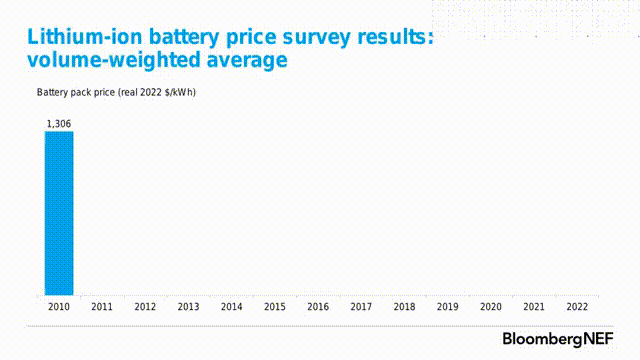
This year, revenue in the EV market is projected to reach $457.60 billion. Additionally, it’s expected to show an annual growth rate up to 2027 of 17.02%, which would result in a projected market volume of $858.00 billion by 2027. Despite these high numbers and the increasing demand that surrounds EVs, OEMs are struggling to make a profit from the sale of EVs. Indeed, as they cost around $12,000 more to produce than their equivalent internal combustion engine vehicles, car makers are finding it difficult to make up for those costs through pricing. As a result, except for the more premium models, OEMs are struggling to get a reasonable profit margin on EVs sold. Can a different battery structure make producing EVs more financially sustainable for OEMs, help reduce these threats and increase their profitability?
Materials Needed for EV Batteries
The increasing demand for EVs has resulted in shortages and high costs of the materials required for their batteries. In the USA alone, the government is hoping that by 2030, EVs will account for 50% of all new car sales. Similarly in China, currently the largest EV market in the world, the country is aiming for EVs to account for 40% of all car sales. The European Union wants at least 30 million zero-emission vehicles on its motorways by that time. As a result, the International Energy Agency estimates that demand for battery materials, including copper will grow sevenfold by 2030.
Shortages and High Costs
This surge in demand, paired with supply chain disruptions, has led to a significant increase in the price of copper. Indeed, while copper was $7.21/kg in September 2022, the cost has steadily risen and since January has been just over $8/kg almost consistently. With 82 kg of copper on average per EV compared to 8-22 kg for a typical internal combustion engine car, the costs quickly start to add up. Furthermore, as the battery holds the largest proportion of costs within an EV, improving their efficiency can reduce the amount of materials needed to achieve a given level of performance, leading to cost savings.
In terms of battery prices, 2022 saw an increase for the first time to an average of $151/kWh. This corresponds to a 7% price hike from 2021 and the first one since BloombergNEF started tracking the market in 2010.

Current Profits for OEMs
With battery costs making up for the largest single factor in EV price differential, combining them with their naturally higher costs has led to OEM profits taking a hit. Indeed, except for some premium models, EV makers stand to lose money on almost every EV they sell. As such, Toyota’s net profit per EV sold stands at a mere $1,197, Volkswagen at $973, Hyundai at $927 and Ford doesn’t even break even at -$762. The ability to improve the efficiency of how batteries are made and how much materials they need can reduce how much is required to achieve a given level of performance, which could lead to cost savings.

Current Structure Limitations for OEMs
With an ever increasing demand for EVs, OEMs are facing various challenges and constraints in terms of producing and delivering EVs in the current environment. This includes the need for more materials, which aren’t readily available, and can lead to increased production costs and reduced profits. Consequently, impacting retail costs, OEM profitability, and their overall operations.
When OEMs require more materials to produce their EVs, it directly translates into higher expenses. Indeed, the cost of raw materials, components, and parts needed for manufacturing can significantly impact the overall production costs. As such, when the prices of these materials rise or become scarce, it can put a strain on the profitability of OEMs as they absorb the costs. Moreover, if these material cost differences are high, OEMs may need to pass this onto customers, risking a decrease in demand. In this highly competitive market, OEMs face the challenge of balancing the need for more materials with the pressure to offer competitive pricing. Therefore, if their competitors can produce similar products at lower costs, OEMs can struggle to maintain market share. As a result, a viable alternative to reduce the need for various materials and keep production costs down must be put in place for operations to continue in favor of OEMs.
How Can OEMs and Battery Manufacturers Proceed?
With the battery price a potential threat to automakers' EV profitability and supply, OEMs must find ways to reduce these gaps without negatively impacting the EV itself. OEMs themselves and battery manufacturers are tackling these challenges through the more efficient manufacturing techniques, different materials and the utilization of new battery and manufacturing technologies such as 3D current collectors.
Revolutionizing the Industry with Addionics 3D Current Collectors
Addionics’ chemistry agnostic Smart 3D Current Collectors for the battery electrodes can reduce the cost of EV battery production by using smaller quantities of different materials. Indeed, as a drop-in solution that’s compatible with all chemistries, whether existing and emerging, Addionics Smart 3D Current Collectors can be added to any production line without any further manufacturing costs. Furthermore, as the technology features an AI structure optimization algorithm, the software is integrated into the battery’s hardware to create a smart and complete solution. As a result, EV makers producing at scale are able to make important cost savings at the same time as improving their profits.
Discover Addionics' technology or contact us for collaboration opportunities.
